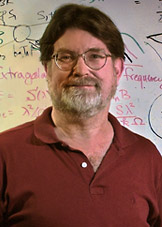Imagine the Universe News - 03 October 2006
Nobel Prize Awarded to Mather and Smoot for NASA's Picture of a Newborn Universe
| 03 October 2006 |
 John C. Mather |
 George F. Smoot |
The Royal Swedish Academy of Sciences has awarded the Nobel Prize in Physics for 2006 jointly to John C. Mather of NASA's Goddard Space Flight Center and George F. Smoot University of California, Berkeley. The Academy awarded them the prize "for their discovery of the blackbody form and anisotropy of the cosmic microwave background radiation".
The prize was awarded for work based on measurements made with NASA's Cosmic Background Explorer (COBE) satellite launched in 1989. These measurements look back into the infancy of the Universe and attempt to gain some understanding of the origin of galaxies and stars.
|
The spectrum of the cosmic microwave background taken by COBE. The error bars on the data points are smaller than the line drawn. The presentation of this plot at a meeting of American Astronomical Society produced a standing ovation among the gathered astronomers. (Click on image for larger version.) |
The COBE results provided increased support for the Big Bang scenario for the origin of the Universe, as this is the only scenario that predicts the kind of cosmic microwave background radiation measured by COBE. These measurements also marked the inception of cosmology as a precise science.
According to the Big Bang scenario, the cosmic microwave background radiation is a relic of the earliest phase of the Universe. Immediately after the big bang itself, the Universe can be compared to a glowing body emitting radiation in which the distribution across different wavelengths depends solely on its temperature. The shape of the spectrum of this kind of radiation has a special form known as blackbody radiation. When it was emitted the temperature of the Universe was almost 3,000 degrees Centigrade. Since then, according to the Big Bang scenario, the radiation has gradually cooled as the Universe has expanded. The background radiation we can measure today corresponds to a temperature that is barely 2.7 degrees above absolute zero. Using COBE, Mather and Smoot were able to calculate this temperature thanks to the blackbody spectrum revealed by the COBE measurements.
|
The temperature variations in the cosmic microwave background as detected across the sky by COBE. (Click image for larger version.) |
COBE also had the task of seeking small variations of temperature in different directions. Extremely small differences of this kind in the temperature of the cosmic background radiation - in the range of a hundred-thousandth of a degree - offer an important clue to how the galaxies came into being. The variations in temperature show us how the matter in the Universe began to "aggregate". This was necessary if the galaxies, stars and ultimately life like us were to be able to develop. Without this mechanism matter would have taken a completely different form, spread evenly throughout the Universe.
COBE was launched using its own rocket on 18 November 1989. The first results were received after nine minutes of observations: COBE had registered a perfect blackbody spectrum. When the curve was later shown at a meeting of the American Astronomical Society in January 1990, the results received a standing ovation.
The success of COBE was the outcome of prodigious team work involving more than 1,000 researchers, engineers and other participants. John Mather coordinated the entire process and also had primary responsibility for the experiment that revealed the blackbody form of the microwave background radiation measured by COBE. George Smoot had main responsibility for the instrument which measured the small variations in the temperature of the radiation.
The COBE measurements have been refined by the Wilkinson Microwave Anistoptropy Probe (WMAP). Very soon the European Planck satellite will be launched in order to study the radiation in even greater detail.



